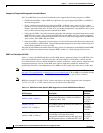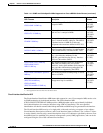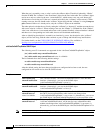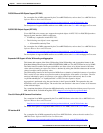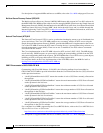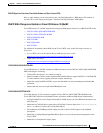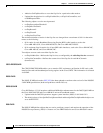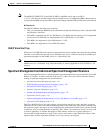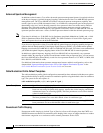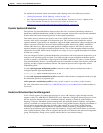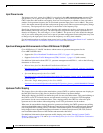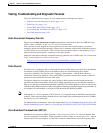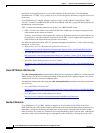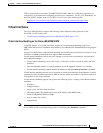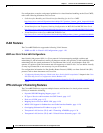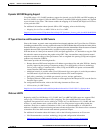
1-120
Cisco uBR7200 Series Universal Broadband Router Software Configuration Guide
OL-2239-05
Chapter1 Overview of Cisco uBR7200 Series Software
cops tcp window-size
Advanced Spectrum Management
In addition to other features, Cisco offers advanced spectrum management features for optimal selection
of the hop-to frequency (optimal frequency hopping) with the advent of the Cisco uBR-MC16S spectrum
management card. The Cisco uBR-MC16S features advanced spectrum management capability that
records signal-to-noise (SNR) information from 5-to-42 MHz for each upstream port for the purpose of
determining noise level, and to identify potential clear spectrum in the event of the need to initiate a
frequency hop. When the number of missed station management messages exceeds a configured
threshold, an upstream channel frequency reassignment is initiated. The Cisco uBR-MC16S scans the
upstream spectrum and locates a clean, available upstream channel within the defined spectrum group.
Note Clean band is defined as > 29 db SNR for 16 Quadrature Amplitude Modulation (QAM), and > 19 db
SNR for Quadrature Phase Shift Keying (QPSK). The SNR calculation is based on the signal power
level, noise power level over the desired bandwidth.
If you choose to bypass the existing Cisco uBR-MC16S optimal frequency hopping capability designed to
optimize the look-ahead capability of the Digital Signal Processors (DSPs), it is possible enforce guided
hopping as used on the Cisco uBR-MCxC and Cisco uBR-MC16E line cards. Cisco does not recommend that
you disable the optimal frequency hopping feature of the Cisco uBR-MC16S for normal operations.
In addition to optimal frequency hopping, the Cisco uBR-MC16S can dynamically vary upstream
channel widths. By entering an optional second channel width value per upstream port, you can instruct
the Cisco uBR-MC16S to hierarchically search for clean upstream channels of 3.2 MHz, 1.6 MHz, 800
kHz, 400 kHz, and 200 kHz width.
For additional information about spectrum management features and their configuration, refer to the
chapter titled “Spectrum Management for the Cisco Cable Modem Termination System” in the
CiscoCable Modem Termination System Feature Guide on Cisco.com.
Cable Modulation Profile Default Templates
The cable modulation-profile global configuration command has been enhanced with three new options
that provide the ability to quickly create basic modulation profiles using the default values for each burst
type. The syntax for the new options is:
cable modulation-profile profile [ mix | qam-16 | qpsk ]
Syntax Description
Downstream Traffic Shaping
Downstream traffic shaping (to include Type-of-Service) allows traffic shaping from the CMTS on a
DOCSIS downstream channel. Downstream traffic shaping limits surges on output interfaces to reduce
downstream congestion or to conform to traffic contract parameters such as PCR.
profile Specifies the modulation profile number (1-8).
mix Creates a default QPSK/16-QAM mix modulation profile where short and long grant
bursts are sent using 16-QAM, while request, request data, initial ranging, and station
maintenance bursts are sent using QPSK). The burst parameters are set to their default
values for each burst type.
qam-16 Creates a default 16-QAM modulation profile, where all bursts are sent using 16-QAM.
The burst parameters are set to their default values for each burst type.
qpsk Creates a default QPSK modulation profile, where all bursts are sent using QPSK. The
burst parameters are set to their default values for each burst type.



